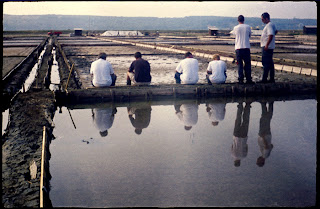It
has been said that necessity is mother of all invention, but I disagree. Other
»mothers of invention«, in my view, are also vanity, frustration and other »virtues«, but they are often confused with the first mother, necessity.
Anyway, there too many things to list humans invented just for the sake of their own satisfaction, not really necessity,
and some of them are even nice gadgets.
I
always »needed«-actually just wanted to have-a small, pocket-size exposure
meter, but never wanted to spend a small fortune for one. I have my trusty,
almost 20-year-old Minolta Auto Meter III which never let me down. But it is a
bulky meter. I just wanted to have a small meter when I get out with a 35 mm
camera, with no bags or whatever. Thus, the meter should fit in a small pocket.
You can even get an old used one for about 20€, but they tend to be unreliable
and in many cases, not working. You can get the small and sweet Sekonic
Twinmate, but I just never wanted to spend some 100€ or so for one. Nowadays
even less so, since for the same money you can buy a film SLR in very good
condition....
So,
the plan is to build one simple but precise (enough) incident light meter for
about 20€ or so in materials and components. The exp.meter must be:
-small
-lightweight
-simple
(both in operation and circuitry)
-precise
within ±0.3 EV
-usable
at least from 15 EV (the »sunny 16« conditions) down to about 4 EV (exposure
value, ISO 100)-this is also the range of many commercial meters
I
already checked the availability/pricing of components, but they still need to
be delivered...in the mean time, I'll lay down the theoretical aspects of this
building issue.
The
sensor
The
easiest approach (and maybe even the most effective) is to use a CdS (cadmium
sulfide) photoresistor (light dependent resistor –LDR). It has the nice property of a logarithmic response (of
its resistance) to lighting conditions, but inversely (the resistance decreases
with increasing illumination). The EVs
we deal with, are also a logarithmic arrangement, since by every EV step the
lighting conditions change by a factor of 2 (1 stop). We can thus get (with a
bit of gimmicks) the electrical output (current or voltage) directly related to
the EV value. But we also need to make first an appropriate light diffusor (and
attenuator) for the sensor (since they are quite sensitive).
The
display
The
nicest way would be to use an analog milliammeter or millivoltmeter, but
unfortunately such small meters are very hard to find, plus they are
substantially more expensive than their digital conterparts-and then you can be
quickly out of budget just for the meter! Digital millivoltmeters (we need them
in the range of ±200 mV) are quite expensive (10-15€), more than half of the
budget, but they include all the necessary circuitry for a precise metering. They
usually run on 9 volts. You just provide a battery source and the measuring
leads for your signal, and of course, some room in the housing of your meterJ The use of a 7-segment or LCD display (while
cheaper) would dictate the use of the necessary A/D converter and drivers
chips, which would substantially complicate the circuitry and eventually, you
could spend (more or less) the same amount of money.
The
battery
An
ordinary 9 volt battery is just fine, but not of my taste-too heavy and bulky.
Instead, you can get a 9V battery of the 23A-type(used in remote controls), but
very rare. Or you can use its 12v counterpart (also used in remotes), since its
easier to get and cheaper. Smaller than a AAA battery, and you can even adapt a
AAA battery holder for it.
The
housing
Any
plastic case of suitable dimensions can do the job-you can even recycle some
old stuff. Or you buy one for a few € or $. Just be sure it can fit the
voltmeter, the battery and the circuit. Along with the housing, we also need a
switch to turn on the circuit for metering.
The
circuit
I
really like simple things, so I did not include any integrated circuits, only
discrete components, and the least amount of active (semiconductor) components
as well. In the hand-drawn circuit draft shown below there are no actual values
shown, since I don't know yet how the LDR will behave. Only after that I can
calculate the actual values to fit my needs. But I do know that I want the
output to be 10 mV/ EV (for increased accuracy); at 15 EV (»sunny 16«) I want
to get as close as possible to 150 mV, while at the low end I want about 40 mV
for 4 EV.
The
resistors Rz1 and Rz2 are just regulating the currents for the voltmeter and
the sensor circuit, respectively. The first Zener diode ZD1 serves to supply
the 9V needed for the voltmeter, while the ZD2 will be set later, when the LDR
behavior will be known, as also the values of other resistors R1, R2 and R3.
But we do know that the output will be according to this formula:
UOUT=
(UZ2 * R1)/(Rx+R1) *
R3/(R2+R3)
So
we have 4 parameters to play with (UZ2 and R1-3) to adjust them to
our needs. Maybe we can later add a couple of diodes to adjust the input
voltage level, but we'll see. Anyway, I like this simplicity and I just can't
wait to do the actual test, next time.


























